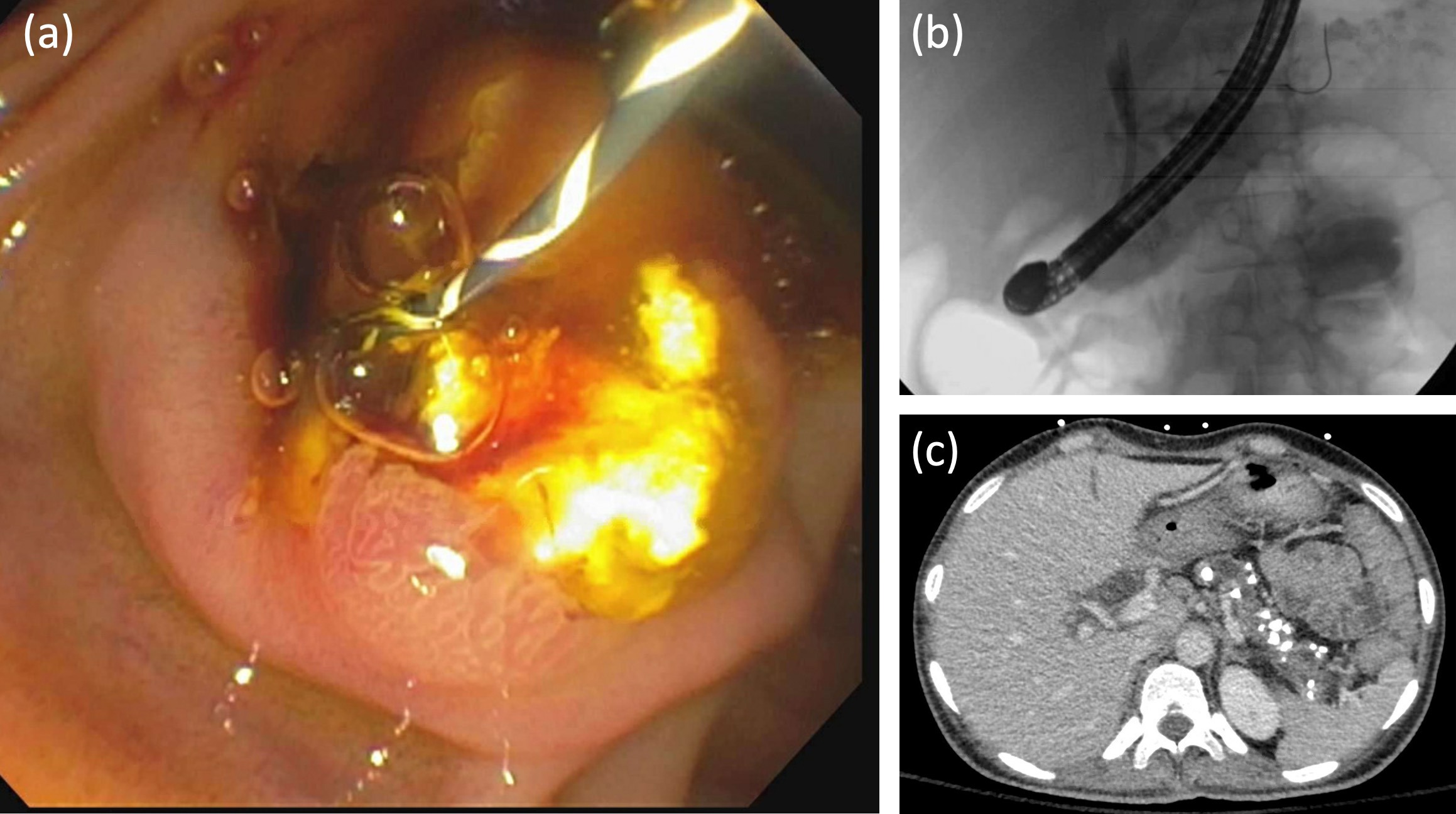Back
Poster Session A - Sunday Afternoon
A0036 - Pancreatic Stones, Abdominal Groans, and Encephalopathic Overtones Presented by a Type 3c Diabetes and Familial Hypocalciuric Hypercalcemia Duet
Sunday, October 23, 2022
5:00 PM – 7:00 PM ET
Location: Crown Ballroom
.jpg)
Lily Kuo, MD
University of Texas Health San Antonio
San Antonio, TX
Presenting Author(s)
Lily Kuo, MD1, Javier Monagas, MD2, Laura Rosenkranz, MD1
1University of Texas Health San Antonio, San Antonio, TX; 2Baylor College of Medicine, The Children's Hospital of San Antonio, San Antonio, TX
Introduction: Chronic pancreatitis related to hypercalcemia may occur in genetic conditions such as Familial Hypocalciuric Hypercalcemia (FHH). Recurrent episodes of hypercalcemia-induced acute pancreatitis result in chronic pancreatitis, marked by pancreatic edema, necrosis, and fibrinogenesis. Progression of pancreatic dysfunction to endocrine insufficiency results in pancreatogenic (type 3c) diabetes, present in 0.5-1% of all patients with diabetes. We present a rare case of FHH induced chronic pancreatitis, complicated by type 3c diabetes.
Case Description/Methods: A 24 year-old female with history of insulin-dependent diabetes mellitus (IDDM) presented with acute encephalopathy, right upper quadrant abdominal pain, and oliguria. Patient was diagnosed with IDDM at a young age after several episodes of recurrent acute pancreatitis of unknown etiology. Her mother and maternal grandmother had history of recurrent acute pancreatitis. Patient was diagnosed with sepsis secondary to gram negative bacteremia suggestive of cholangitis, with elevated ionized calcium of 1.83. Hypercalcemia evaluation revealed fractional excretion of calcium of < 1%, diagnostic of FHH. CT scan revealed a dilated common bile duct (CBD) up to 10 mm without stones, absence of cholelithiasis, diffuse pancreatic calcifications, and a dilated main pancreatic duct (PD) up to 12 mm, consistent with chronic pancreatitis. Endoscopic retrograde cholangiopancreatography revealed a large pancreatic duct stone lodged at the ampulla. Cholangiogram showed a dilated biliary tree without filling defects. The PD was severely dilated and contained sludge and stones. Dual sphincterotomy was performed with retrieval of pancreatic duct stones only. Patient met criteria for type 3c diabetes when further workup revealed negative anti-glutamic acid decarboxylase antibodies.
Discussion: FHH is a rare, benign cause of hypercalcemia, characterized by inactivating mutations of the calcium-sensing receptor (CASR). Via CASR, sustained hypercalcemia prematurely activates trypsinogen and depletes ATP, leading to pancreatic inflammation and necrosis. The role of CASR in pathogenesis of recurrent acute and chronic pancreatitis has been debated in several clinical reviews. Type 3c diabetes is a consequence of chronic pancreatitis and presents at higher rates in patients with early onset calcific pancreatic disease. Our case highlights a rare etiology of recurrent acute and chronic pancreatitis.

Disclosures:
Lily Kuo, MD1, Javier Monagas, MD2, Laura Rosenkranz, MD1. A0036 - Pancreatic Stones, Abdominal Groans, and Encephalopathic Overtones Presented by a Type 3c Diabetes and Familial Hypocalciuric Hypercalcemia Duet, ACG 2022 Annual Scientific Meeting Abstracts. Charlotte, NC: American College of Gastroenterology.
1University of Texas Health San Antonio, San Antonio, TX; 2Baylor College of Medicine, The Children's Hospital of San Antonio, San Antonio, TX
Introduction: Chronic pancreatitis related to hypercalcemia may occur in genetic conditions such as Familial Hypocalciuric Hypercalcemia (FHH). Recurrent episodes of hypercalcemia-induced acute pancreatitis result in chronic pancreatitis, marked by pancreatic edema, necrosis, and fibrinogenesis. Progression of pancreatic dysfunction to endocrine insufficiency results in pancreatogenic (type 3c) diabetes, present in 0.5-1% of all patients with diabetes. We present a rare case of FHH induced chronic pancreatitis, complicated by type 3c diabetes.
Case Description/Methods: A 24 year-old female with history of insulin-dependent diabetes mellitus (IDDM) presented with acute encephalopathy, right upper quadrant abdominal pain, and oliguria. Patient was diagnosed with IDDM at a young age after several episodes of recurrent acute pancreatitis of unknown etiology. Her mother and maternal grandmother had history of recurrent acute pancreatitis. Patient was diagnosed with sepsis secondary to gram negative bacteremia suggestive of cholangitis, with elevated ionized calcium of 1.83. Hypercalcemia evaluation revealed fractional excretion of calcium of < 1%, diagnostic of FHH. CT scan revealed a dilated common bile duct (CBD) up to 10 mm without stones, absence of cholelithiasis, diffuse pancreatic calcifications, and a dilated main pancreatic duct (PD) up to 12 mm, consistent with chronic pancreatitis. Endoscopic retrograde cholangiopancreatography revealed a large pancreatic duct stone lodged at the ampulla. Cholangiogram showed a dilated biliary tree without filling defects. The PD was severely dilated and contained sludge and stones. Dual sphincterotomy was performed with retrieval of pancreatic duct stones only. Patient met criteria for type 3c diabetes when further workup revealed negative anti-glutamic acid decarboxylase antibodies.
Discussion: FHH is a rare, benign cause of hypercalcemia, characterized by inactivating mutations of the calcium-sensing receptor (CASR). Via CASR, sustained hypercalcemia prematurely activates trypsinogen and depletes ATP, leading to pancreatic inflammation and necrosis. The role of CASR in pathogenesis of recurrent acute and chronic pancreatitis has been debated in several clinical reviews. Type 3c diabetes is a consequence of chronic pancreatitis and presents at higher rates in patients with early onset calcific pancreatic disease. Our case highlights a rare etiology of recurrent acute and chronic pancreatitis.

Figure: Hypercalcemia-induced chronic pancreatitis evidenced by (a) ERCP with evidence of pancreatic duct stone lodged in ampulla, (b) cholangiogram with biliary tree dilation, and (c) CT with diffuse pancreatic calcifications
Disclosures:
Lily Kuo indicated no relevant financial relationships.
Javier Monagas indicated no relevant financial relationships.
Laura Rosenkranz indicated no relevant financial relationships.
Lily Kuo, MD1, Javier Monagas, MD2, Laura Rosenkranz, MD1. A0036 - Pancreatic Stones, Abdominal Groans, and Encephalopathic Overtones Presented by a Type 3c Diabetes and Familial Hypocalciuric Hypercalcemia Duet, ACG 2022 Annual Scientific Meeting Abstracts. Charlotte, NC: American College of Gastroenterology.
